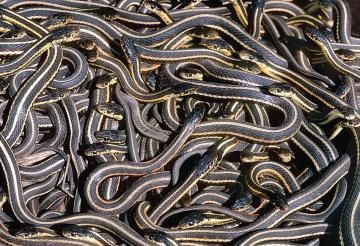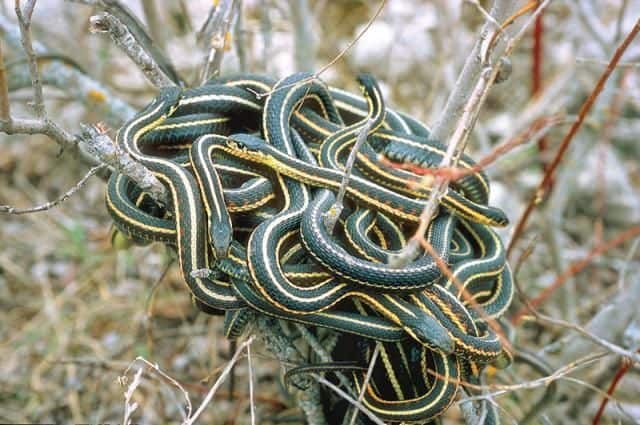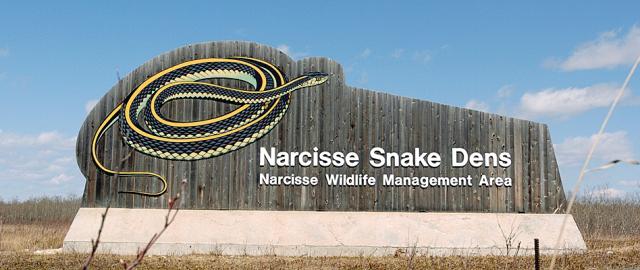Narcisse Snake Dens

Trail Length: 3 kilometres
Difficulty: Easy - Family
Park Amenities:
Narcisse Snake Dens
By Tania Moffat
A land where it can reach 50 degrees below zero seems an unlikely spot for the world’s largest concentration of cold-bodied reptiles to reside.
But it is here, in the Interlake, where one of the most amazing, naturally occurring events in the wild can be experienced. Networks of caverns have formed over time in the limestone bedrock that is located close to the surface. Cold prairie temperatures and erosion have caused the limestone substrate to crack, creating fissures opening up large sinkholes, allowing the snakes to hibernate below the frost line.
Here, the largest population of overwintering red-sided garter snakes in the world gather together in writhing, tangled masses as they perform their spring mating ritual.
The dens have garnered worldwide recognition due to their northern location; this garter snake is the only reptile known to survive so prolifically in such a cold climate. There are a limited number of den sites, only four in fact, which enables this massive gathering of snakes in the spring as they try to mate before departing to the surrounding marshes for the summer. In the fall, they return to the dens, following the pheromones of other snakes, where tens of thousands gather to overwinter in a space the size of a living room.
From the end of April through to the beginning of May, tourists and scientists from all over the world travel to the Narcisse Snake Dens to view this spectacle brought on by spring’s melting snow and warming ground − the signal for this mass of snakes to awake and leave their winter homes in the limestone dens.
Our provincial snake ambassadors are much like Manitobans − friendly. They are harmless creatures with tiny teeth they only use for eating. In reality, our cold-blooded male pals may not be so much friendly as they are completely oblivious to people or anything that is not a female snake. Still, there is no fighting for territory or acts of domination.
Male snakes outnumber females a hundred to one; aroused by the slightly larger female snake’s pheromones, they surround her in droves hoping to be that special guy. They get so wrapped up in their quest that they can tumble downhill in large “mating balls” of writhing forms.
Snakes in these numbers are not a symbol of doom but rather the opposite – a symbol of a healthy, thriving ecosystem.
Narcisse offers a once-in-a-lifetime experience to be surrounded by scores of snakes, who really just ignore you. It is thrilling to experience. The sound of their scaled bodies scraping together combined with the roar of thousands of almost silent hisses is incredible.
After taking a closer look at them, you may find they are actually quite cute with their large unblinking doe eyes and gentle nature. Should you be brave enough to pick one up, you’ll find they are cool to the touch and just wriggle through your fingers. They may be small but you can feel the power in their lithe little bodies.
Warm sunny days in the spring and fall are the best times for viewing, but be sure to check the website gov.mb.ca/conservation/wildlife/spmon/narsnakes/snakes_status.html, which provides accurate updates on snake activity and also offers directions for the one-and-a-half hour scenic drive north of Winnipeg.
Signs guide motorists to the entrance equipped with washrooms, a picnic area, and the start of a three kilometre walking trail. Interpretive signs line the crushed limestone trail that winds through native grasses and an aspen forest, leading to boardwalks and viewing platforms near the dens. The site is managed by Manitoba Conservation and the Narcisse Snake Management Advisory Group to minimize the tourists’ impact on the snakes. This is a fun event for all, and a child favourite.
Address:





